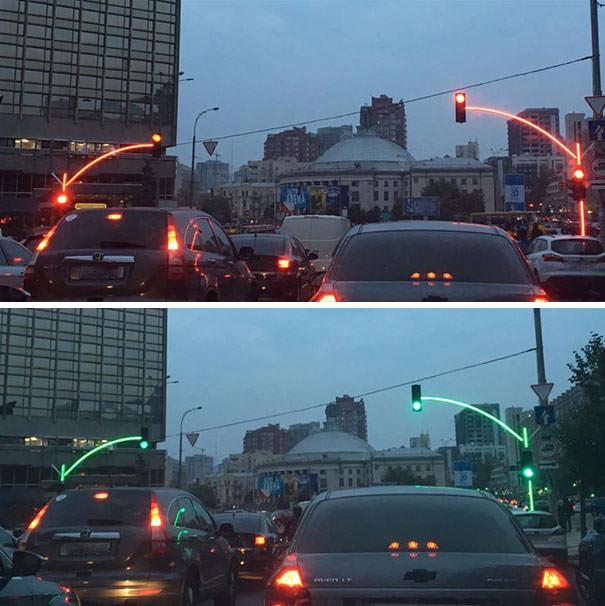Showing Tag: "traffic" (Show all posts)
Traffic Signals in Ukraine
Posted by Steve Fitzsimons on Friday, June 4, 2021,
In :
For the General Public
How do you make a traffic signal look pretty?
Posted by Steve Fitzsimons on Friday, January 31, 2020,
In :
For the General Public
Traffic Signal Timing in San Jose
Posted by Steve Fitzsimons on Thursday, July 26, 2018,
In :
For the General Public
Traffic Signal Simulation - Is it time for an udpate?
Posted by Steve Fitzsimons on Monday, September 19, 2016,
In :
For Traffic Signal Designers
Traffic Adaptive Systems in the US
Posted by Steve Fitzsimons on Wednesday, July 2, 2014,
In :
For ITS Designers
LED Traffic Signal Heads can get clogged with snow
Posted by Steve Fitzsimons on Tuesday, December 29, 2009,
In :
For Traffic Signal Designers
Left turn wait time
Posted by Steve Fitzsimons on Monday, December 28, 2009,
In :
For the General Public
New Bicycle Standards
Posted by Steve Fitzsimons on Thursday, December 3, 2009,
In :
For Traffic Signal Designers
When do traffic signals get installed?
Posted by Steve Fitzsimons on Friday, October 30, 2009,
In :
For the General Public
Caltrans Traffic Count Database
Posted by Steve Fitzsimons on Wednesday, August 5, 2009,
In :
For Traffic Signal Designers
Left Turn Signal Head Placement
Posted by Steve Fitzsimons on Thursday, July 16, 2009,
In :
For Traffic Signal Designers
Slower Traffic Keep Right
Posted by Steve Fitzsimons on Tuesday, July 14, 2009,
In :
For the General Public
Traffic signal basics
Posted by Steve Fitzsimons on Friday, July 10, 2009,
In :
For the General Public
Controller Extensions
Posted by Steve Fitzsimons on Thursday, June 25, 2009,
In :
For Traffic Signal Designers
About Us
| Steve Fitzsimons |
| Oakland, Ca |
 If you would like to ask a question about driving rules, traffic signals or street lights, send your questions to:
SFitzsimons@W-Trans.com or call 650-314-8313.
Steve Fitzsimons is a professional Civil Engineer and Traffic Engineer in California. He is a principal at W-Trans. Find out more about W-Trans at www.w-trans.com
****
If you need a traffic signal design or review, W-Trans is available for hire. If you are an electrical contractor, W-Trans is available for hire to prepare timing plans or traffic control plans.
If you would like to ask a question about driving rules, traffic signals or street lights, send your questions to:
SFitzsimons@W-Trans.com or call 650-314-8313.
Steve Fitzsimons is a professional Civil Engineer and Traffic Engineer in California. He is a principal at W-Trans. Find out more about W-Trans at www.w-trans.com
****
If you need a traffic signal design or review, W-Trans is available for hire. If you are an electrical contractor, W-Trans is available for hire to prepare timing plans or traffic control plans.
|
Blog Archive
- June 2009
- July 2009
- August 2009
- September 2009
- October 2009
- November 2009
- December 2009
- January 2010
- February 2010
- March 2010
- June 2010
- September 2010
- November 2010
- December 2010
- January 2011
- February 2011
- April 2011
- May 2011
- August 2011
- October 2011
- November 2011
- December 2011
- February 2012
- May 2012
- July 2012
- August 2012
- September 2012
- October 2012
- December 2012
- January 2013
- September 2013
- October 2013
- February 2014
- July 2014
- September 2014
- October 2014
- January 2015
- December 2015
- March 2016
- June 2016
- September 2016
- December 2016
- February 2017
- March 2017
- May 2017
- July 2017
- August 2017
- October 2017
- November 2017
- December 2017
- January 2018
- May 2018
- June 2018
- July 2018
- August 2018
- September 2018
- December 2018
- March 2019
- May 2019
- July 2019
- September 2019
- January 2020
- July 2020
- September 2020
- June 2021
- September 2021

